Windows Phone 8.1 Review
by Anand Lal Shimpi on April 14, 2014 10:00 PM EST- Posted in
- Smartphones
- Microsoft
- Mobile
- windows phone
- Windows Phone 8.1
Action Center
With Windows Phone 8.1, all three of the major smartphone platforms now have some form of a unified notification hub, all accessed by pulling a shade down from the top of the screen. Microsoft’s attempt is called Action Center, and like most aspects of Windows Phone it occupies a middle ground between Android and iOS.
Microsoft’s Action Center gives you direct access to four different shortcuts, the settings menu, and notifications from your apps. All aspects of Action Center are user definable. You can control what shortcuts appear at the top of the shade and you can choose what apps get to display their notifications.
The user customizable launch shortcuts are awesome, although I would like to have one or two more shortcuts to avoid scrolling through the mess that is the Windows Phone settings page.
There’s a clear all button in Action Center that not only wipes the screen clean of all notifications, but also propagates the clearing effect down to live tiles as well. In the screenshot below you see I have two emails in my AnandTech account and nine in my Gmail account:
Clearing all notifications in Action Center clears the unread email counter on both live tiles.
The emails remain unread in the apps themselves, which is what you’d expect. If you want to just clear notifications for a single app, just swipe anywhere over the notifications for that app.
Pulling down on the Action Center also reveals a little more information in the Windows Phone status bar. You now get a battery percentage indicator, today’s date and the name of the cellular network you’re connected to. The status bar no longer automatically hides itself either. WiFi and cellular signal strength, notification (if applicable) and battery indicators are all permanently on display.
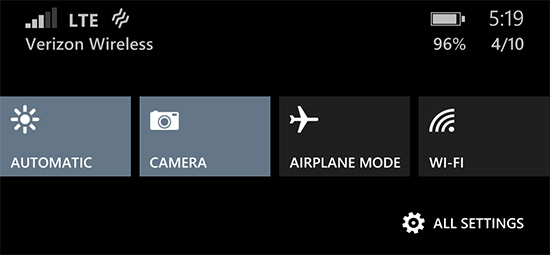
Microsoft also exposes individual volume controls for notifications (including the ringer) and media playback.
Cortana
Apple has Siri, Google has Google Now, and Microsoft has Cortana. Pulled straight out of the Halo universe, Cortana ends up being a mix of Siri and Google Now. Cortana launches in beta with the same sort of basic voice assistance you get with Siri in iOS. Hitting the search button will take you to Cortana, while holding it down automatically puts her in listening mode. You can set reminders (including those based on location), create/move calendar events, ask about nearby shops/restaurants, place calls and dictate text messages.
Anything that doesn’t fall into a category that guarantees a verbal response from Cortana triggers a Bing search. By default all Bing searches are aimed at the web but by swiping to the right you can redirect search towards your device itself. Phone search is universal and it’ll index everything from apps to text messages and emails. Cortana features integrated music recognition as well. Just tap the music icon and within a few seconds, if the track exists in the Xbox Music store it'll be identified.
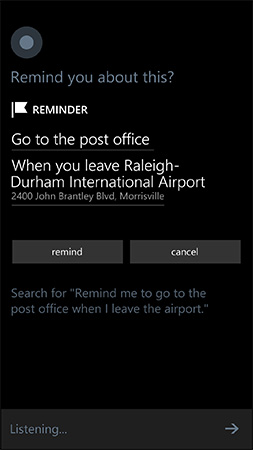 |
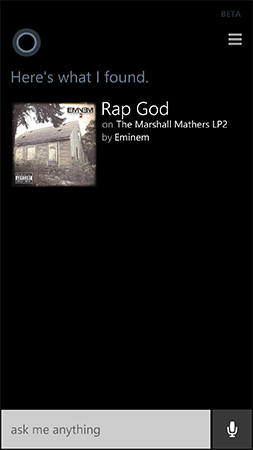 |
Cortana’s basics work well thanks to Microsoft’s extremely accurate (and speedy) voice recognition. You don’t have to use voice to interact with Cortana, typing is supported as well.
Cortana can prevent incoming notifications from surfacing while you sleep or are in a meeting using a feature called quiet hours. Similar to iOS6’s Do Not Disturb mode, Quiet Hours can be configured to allow certain contacts to break through. In an expansion over what iOS DND can do, Cortana can also instruct contacts who aren’t a part of your “inner circle” to text with a certain passphrase in order to break through quiet hours. Similarly, if any contact calls twice within a 3 minute period they’ll be exempted from quiet hours as well.
Unfortunately Cortana’s usefulness, much like Siri’s, can be quite limited. She’s great for settling alarms and creating meetings, but deeper natural language conversations just can’t happen yet. Cortana can save you from typing something, but that’s about the extent of her usefulness as a voice interaction tool.
This is where Cortana’s notebook comes in handy. If you allow her to, Cortana will look at your emails and monitor your behavior to determine what information she should float up to your attention. The result is a Google Now like experience, where you get things like reminders of upcoming flights based on emails in your inbox, as well as estimated commute time based on where Cortana thinks you live and work. You can give Cortana hints about your interests and she’ll use Bing news to grab headlines you might want to read. I feel like this is ultimately where these virtual digital assistants will end up, but we’re still at a very early stage in their evolution.
It’s interesting to note that Apple is now the only major smartphone player without a notebook/Google Now-like feature on its mobile platform. It’s no coincidence that the two players that do have that feature also derive revenue from selling advertising against user data. Once features like Cortana and Google Now get good enough, the obvious next step is to send highly targeted advertisements to the end user. It’s not necessarily a bad thing, but it’s clear that’s going to be the next major jump in advertising on mobile.



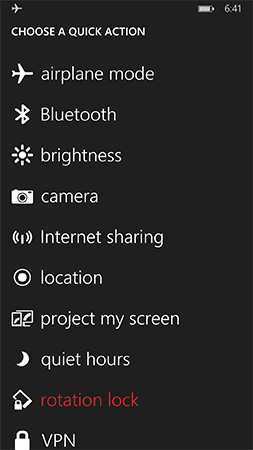
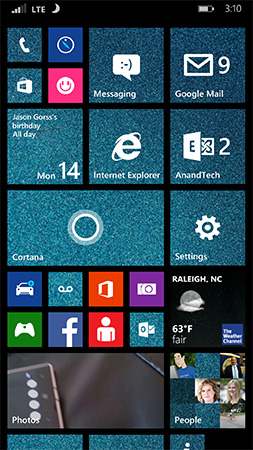
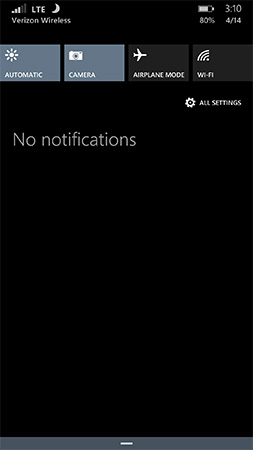
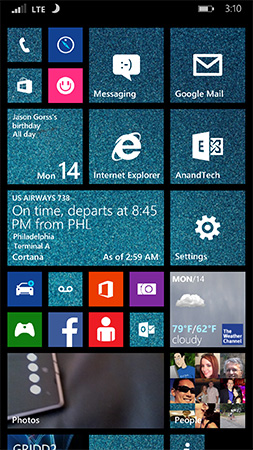
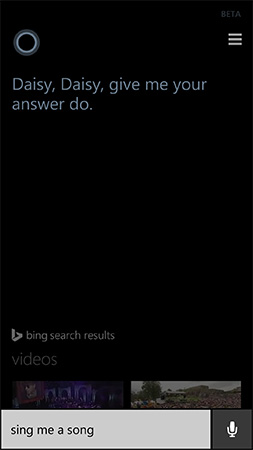
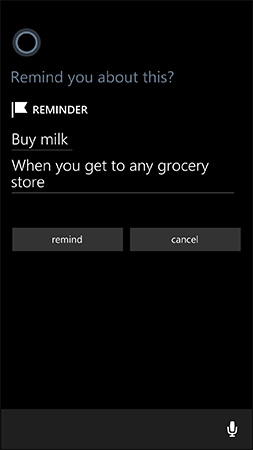
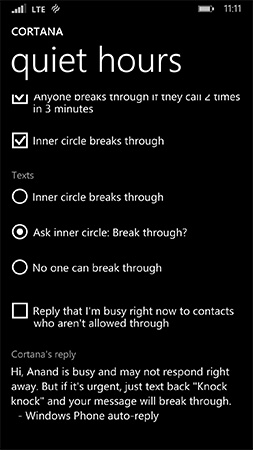
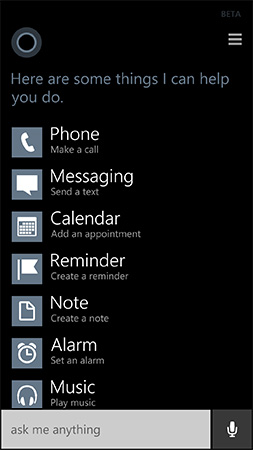
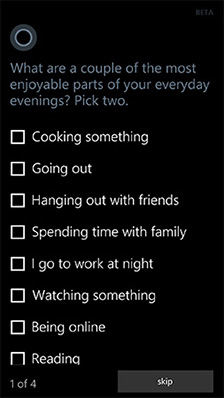
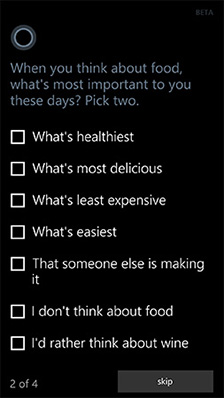
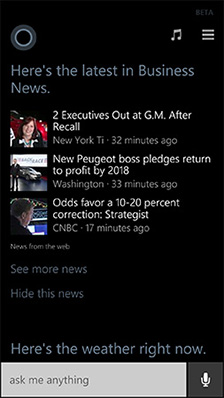








111 Comments
View All Comments
rgba32bit - Saturday, April 19, 2014 - link
Really like my 8X can't wait for my contract to be up to get the Icon or similar. All the reviews pose the question can windows phone beat android, ios... what os is better or inferior. Like it needs to be black and white. I think it can now be said WP isn't going away and is firmly number 3. Personally android annoys me and just seems counter intuitive and the form factor of the iPhone was a nonstarter for me. I think it can be said at this point all three are good platforms and it will be better for everyone if it's a three horse race. When I got my 8x I almost never saw another wp but now I see many on the train. The only thing that really annoys me are when people make crazy blanket assertions like wp has no apps because it doesn't have this or that and that it doesn't go the other way at all. Some of my favorite apps aren't on android or ios and work much better for ME then their counterparts. In a world of coke and pepsi I think there's room sprite as well.mean_streets - Saturday, April 19, 2014 - link
I installed the 8.1 dev preview on my Lumia 810, and one of the first things that I noticed when looking at the action center was a "project" to external screen quick action. This seems like a great feature, but I haven't been able to find a word about it in any of the preview articles. I tried plugging in to the USB media connection on two Samsung TV's that we have, but got nothing.BMNify - Saturday, April 19, 2014 - link
Here are the detailed instructions for using "project to screen" feature on WP 8.1:http://www.wpcentral.com/project-your-windows-phon...
lmcd - Saturday, April 19, 2014 - link
I *liked* having games tucked away into the Game Hub -- any way to bring that back with a setting?YoshoMasaki - Tuesday, April 22, 2014 - link
Not currently. But WP8.1 is far from final and especially the decoupled hub apps are expected to see quick updates over the next few weeks until the RTM.rburnham - Wednesday, April 23, 2014 - link
I have 8.1 on my Lumia 920, and it's a mostly good update.I have some complaints though. The ability to use an image as wallpaper is neat, but the fact that some apps do not have transparent tiles interrupts the uniformity of the OS. Oddly enough, it is mostly Microsoft apps (One Note, Podcasts, Music) that lack transparent tiles.
I like that Microsoft replaced Music+Videos with apps for each type of media. The new Podcast app is a big step up from the limited functionality of Music+Video. I like not having to rely on the Store to get podcasts, and that you can add custom feed URLs. I love that you have the option to stream or download shows. It also seems that the download file size limit has increased, because I am seeing shows being downloaded over cellular that previously required WIFi.
However, the Podcast app is buggy. It crashes regularly, audio cuts out, it forgets that podcasts have already been played and downloads them again, and it doesn't automatically delete files. Once these bugs are ironed out, it will be an excellent podcast app. I have to admit that I was initially sour about the way WP8 handles podcasts when compared WP7, but I have completely changed my opinion with this new app.
Lastly, audio options seem to have changed. Before the update, my phone remembered different volume settings for different Bluetooth devices. In my case, it kept the audio level for my car stereo Bluetooth connection at maximum volume (30), and my Bluetooth headset at half volume (15). Now both devices share the same volume level. I would like to see them go back to how it was before.
Also Bluetooth will occasionally cut out completely when I pause a podcast, requiring me to use the Bluetooth settings to manually reconnect, or I have to reset the phone. To be fair, this was a problem before 8.1, so it just means they have not address the issue yet.
If they can iron out these bugs, that would be great. As is, it's still a really good mobile OS that I have enjoyed since WP7.
Fgne - Saturday, April 26, 2014 - link
I think that the force of WP8 is that it runs still extremely well and fast on a hundred dollars device, something that on android devices is simply fantasy, no comment for ios.whatsa - Sunday, April 27, 2014 - link
Nice to see a fair review from this site...The brightness issue? I have found the auto to be excellent on the 1520
I was outside the other day comparing some offline mapping with some people who were camping
and all three of us could see my screen and map clearly but the Iphone was impossible to read and only if it was 4" from you nose and sheilded from the sun. So we all just discussed it looking at my phone from different angles in the sun.
Is it perfect ...no but there are a lot of basic things it just does better.
But thanks again its good to see anandtech willing to look at WP stuff in a more serious way.
bloonsfreak2 - Monday, May 12, 2014 - link
Being a Windows Phone user since the beginning (Lumia 800, 900, 920), I have to admit that one of my favorite features was the integration with Facebook and Skype in the messaging hubs. However, for some odd reason, MSFT decided to remove that feature in Windows Phone 8.1 and now messaging is only for texting, even thought the social integration was probably the best part about it and set it apart from its iOS and Android counterparts. Does anyone know why they did this? Is there any particular reason that make me feel better? All of the other features are amazing, but the messaging hub just isn't really a hub anymore.hangfirew8 - Thursday, May 15, 2014 - link
The Lumia 800 was hardly the beginning of Windows Phone, the 800 debuted at 7.5. There was a lot of wasteland before that. We had a Dash (5/6) years ago, and even that wasn't the beginning.